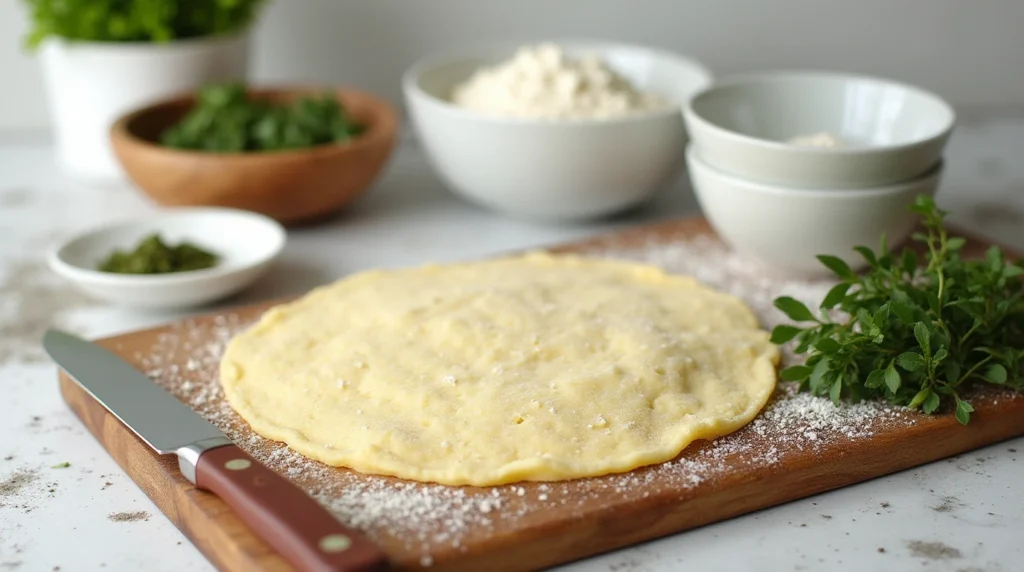Cottage cheese flatbread is a delightful and nutritious option that many people enjoy. However, it can be frustrating when your Cottage cheese flatbread turns out soggy instead of the perfect texture you were hoping for. In this article, we’ll explore the reasons behind this common issue and provide you with practical tips to ensure your cottage cheese flatbread comes out just right every time. From understanding the role of moisture in your ingredients to adjusting your cooking techniques, we’ve got you covered. Let’s dive into the world of cottage cheese flatbread and discover how to achieve that ideal texture!
Introduction to Cottage Cheese Flatbread
Understanding Cottage Cheese Flatbread
Cottage cheese flatbread is a versatile dish that combines the creamy goodness of cottage cheese with the satisfying texture of flatbread. It’s not only delicious but also packed with protein, making it a popular choice for health-conscious individuals. Whether you’re using it as a base for toppings or enjoying it on its own, the right texture is crucial for a delightful eating experience.
Cottage cheese is not only a delicious addition to flatbread but also boasts numerous health benefits. Packed with protein, it supports muscle growth and repair, making it an excellent choice for those looking to maintain a healthy diet. Additionally, it contains essential vitamins and minerals, including calcium, which is vital for bone health. For more detailed information on its health advantages, check out the Nutritional Benefits of Cottage Cheese.
Purpose of the Article
The purpose of this article is to address a common concern: Why is my cottage cheese flatbread soggy? Soggy flatbread can be a real letdown, especially when you’ve put in the effort to make it. Understanding the factors that contribute to this issue is essential for anyone looking to perfect their flatbread-making skills. We’ll explore the common causes of sogginess and provide actionable tips to help you achieve that perfect, fluffy texture. So, let’s get started on this culinary journey!
Common Causes of Soggy Cottage Cheese Flatbread
When it comes to making cottage cheese flatbread, several factors can lead to a soggy outcome. Understanding these common causes is the first step toward achieving the perfect texture. Let’s break down the main culprits that might be ruining your flatbread experience.
Excess Moisture in Ingredients
One of the primary reasons your cottage cheese flatbread might turn out soggy is due to excess moisture in the ingredients. Cottage cheese, while nutritious, can vary significantly in moisture content. If you’re using a brand that’s particularly watery, it can lead to a flatbread that’s more mushy than fluffy.
Moreover, if you’re adding other wet ingredients—like yogurt or even vegetables—without accounting for their moisture, you might be setting yourself up for a soggy disaster. To combat this, consider using low-moisture cottage cheese or draining the excess liquid before mixing it into your dough. This simple step can make a world of difference in achieving that desired texture.
Improper Cooking Techniques
Another common cause of soggy cottage cheese flatbread is improper cooking techniques. Cooking temperature and time play a crucial role in the final product. If your cooking surface isn’t hot enough, the flatbread may not cook evenly, leading to a soggy center.
For instance, if you’re frying your flatbread, make sure your skillet is preheated adequately. A hot skillet helps to create a nice crust on the outside while cooking the inside thoroughly. If you’re baking, ensure your oven is preheated to the right temperature before placing your flatbread inside. This way, you’ll avoid that dreaded sogginess and achieve a beautifully cooked flatbread.
Incorrect Flour-to-Water Ratio
The flour-to-water ratio is another critical factor that can affect the texture of your cottage cheese flatbread. If you’re using too much liquid in relation to the flour, your dough will be too wet, resulting in a soggy flatbread.
To get it right, start with a basic ratio and adjust as needed. A good rule of thumb is to use enough flour to absorb the moisture from the cottage cheese and any other wet ingredients. If your dough feels sticky or overly wet, add a little more flour until you reach a workable consistency. This adjustment can help you achieve that perfect balance and prevent sogginess in your flatbread.
By understanding these common causes of sogginess, you’re already on your way to making better cottage cheese flatbread.
Tips to Prevent Soggy Cottage Cheese Flatbread

Now that we’ve identified the common causes of sogginess in cottage cheese flatbread, it’s time to focus on solutions. Here are some practical tips to help you achieve that perfect texture, ensuring your flatbread is fluffy and delicious every time.
Choosing the Right Ingredients
The first step in preventing soggy cottage cheese flatbread is selecting the right ingredients. Not all cottage cheese is created equal, and the moisture content can vary widely between brands.
Opt for low-moisture cottage cheese whenever possible. This type will help reduce the overall liquid in your dough, leading to a firmer flatbread. If you can’t find low-moisture cottage cheese, consider draining regular cottage cheese before using it. Simply place it in a fine-mesh strainer for a few minutes to let the excess liquid drip away. This small adjustment can significantly improve the texture of your flatbread.
Additionally, be mindful of any other wet ingredients you’re adding. If you’re incorporating yogurt, for example, try using a thicker variety or reducing the amount to maintain the right balance of moisture in your dough.
Adjusting Cooking Methods
Your cooking method can also make a big difference in the texture of your cottage cheese flatbread. Whether you’re baking or frying, the right technique is essential for achieving that perfect crust.
If you’re frying your flatbread, make sure to use a hot skillet. Preheat your skillet over medium-high heat before adding the dough. This will help create a nice sear on the outside, locking in moisture and preventing sogginess. You can test the heat by sprinkling a few drops of water on the skillet; if they sizzle and evaporate quickly, it’s ready for cooking.
For baking, ensure your oven is preheated to the correct temperature before placing your flatbread inside. A hot oven will help the flatbread rise and cook evenly, reducing the risk of a soggy center. Consider using a baking stone or a cast-iron skillet for even better results, as these surfaces retain heat well and promote a crispy texture.
Experimenting with Ratios and Additives
Finally, don’t be afraid to experiment with your ratios and additives to achieve the desired texture in your cottage cheese flatbread. If you find that your flatbread is still turning out soggy, try adjusting the flour-to-water ratio. Start with a basic recipe and gradually add more flour until you reach a dough that’s not too sticky.
You can also consider using binders or thickeners to help absorb excess moisture. Ingredients like xanthan gum or psyllium husk can improve the structure of your flatbread, making it less prone to sogginess. Just remember to use these additives sparingly, as a little goes a long way.
By choosing the right ingredients, adjusting your cooking methods, and experimenting with ratios, you can significantly reduce the chances of ending up with soggy cottage cheese flatbread. In the next part, we’ll dive into troubleshooting soggy flatbread, helping you identify the source of the problem and make adjustments for future batches!
Troubleshooting Soggy Flatbread

Even with the best intentions and techniques, sometimes your cottage cheese flatbread can still turn out soggy. Don’t worry! Troubleshooting is part of the cooking process, and understanding how to identify the source of the problem can help you make the necessary adjustments for future batches. Let’s explore how to troubleshoot soggy flatbread effectively.
Identifying the Source of Sogginess
The first step in troubleshooting is to pinpoint what went wrong. Here’s a handy checklist to help you analyze your cooking process:
- Ingredient Quality: Did you use low-moisture cottage cheese? If not, that could be a significant factor. Remember, the moisture content in your ingredients plays a crucial role in the final texture.
- Moisture Management: Did you drain your cottage cheese or any other wet ingredients? If you skipped this step, it might have contributed to excess moisture in your dough.
- Cooking Temperature: Was your skillet or oven preheated adequately? If the cooking surface wasn’t hot enough, your flatbread might not have cooked through properly, leading to a soggy center.
- Flour-to-Water Ratio: Did you follow the recommended ratios? If your dough was too wet, it’s likely that the excess liquid caused the sogginess.
- Cooking Time: Did you cook your flatbread long enough? Under-cooking can leave the inside moist and unappetizing.
By going through this checklist, you can identify the specific areas where things may have gone awry. This reflection will help you make informed adjustments in your next attempt.
Making Adjustments for Future Batches

Once you’ve identified the source of the sogginess, it’s time to make adjustments for your future batches of cottage cheese flatbread. Here are some tips to help you improve your results:
- Keep a Cooking Journal: Document your ingredients, ratios, cooking times, and temperatures. This will help you track what works and what doesn’t, making it easier to replicate successful batches.
- Trial and Error: Don’t be afraid to experiment! Cooking is all about finding what works best for you. If you notice that a particular brand of cottage cheese consistently leads to sogginess, try switching to a different one.
- Adjust Gradually: When making changes to your recipe, do so gradually. For example, if you think you need less moisture, start by reducing it slightly rather than making drastic changes. This way, you can better gauge the impact of each adjustment.
- Seek Feedback: If you’re cooking for others, ask for their input. They might notice things you overlook, helping you refine your technique even further.
By following these troubleshooting steps and making thoughtful adjustments, you’ll be well on your way to perfecting your cottage cheese flatbread.
FAQs About Cottage Cheese Flatbread
As you embark on your journey to perfect cottage cheese flatbread, you might have some lingering questions. In this section, we’ll address some frequently asked questions that can help clarify common concerns and enhance your flatbread-making experience.
1. What can I do if my flatbread is already soggy?
If you find yourself with soggy flatbread, don’t despair! There are a few things you can try to salvage it. First, you can place the soggy flatbread on a baking sheet and pop it in a preheated oven at 350°F (175°C) for about 5-10 minutes. This will help evaporate some of the excess moisture and give it a firmer texture.
Another option is to cut the flatbread into smaller pieces and toast them in a skillet or toaster oven. This can create a crispy texture that makes the flatbread more enjoyable. While it may not be perfect, these methods can help improve the overall experience.
2. Can I freeze cottage cheese flatbread?
Absolutely! Freezing cottage cheese flatbread is a great way to preserve it for later use. To freeze, allow the flatbread to cool completely, then wrap it tightly in plastic wrap or aluminum foil. Place it in an airtight container or a freezer bag to prevent freezer burn.
When you’re ready to enjoy it again, simply thaw it in the refrigerator overnight or reheat it directly from the freezer in a skillet or oven. Just be mindful that freezing may slightly alter the texture, so it’s best to consume it fresh whenever possible.
3. How long should I cook cottage cheese flatbread?
The cooking time for cottage cheese flatbread can vary depending on your cooking method and the thickness of the flatbread. Generally, if you’re frying, cook each side for about 3-5 minutes over medium heat until golden brown. If you’re baking, aim for around 15-20 minutes at 350°F (175°C), or until the edges are crisp and the center is cooked through.
Keep an eye on your flatbread as it cooks, and adjust the time as needed based on your specific stove or oven. Remember, a well-cooked flatbread should be firm and slightly crispy on the outside.
4. What are some variations of cottage cheese flatbread?
Cottage cheese flatbread is incredibly versatile, and you can easily customize it to suit your taste. Here are a few variations to consider:
- Herbed Flatbread: Add fresh or dried herbs like rosemary, thyme, or oregano to the dough for an aromatic twist.
- Spiced Flatbread: Incorporate spices such as cumin, paprika, or garlic powder for added flavor.
- Vegetable Flatbread: Mix in finely chopped vegetables like spinach, bell peppers, or zucchini for a nutritious boost.
- Cheesy Flatbread: For an extra cheesy treat, fold in shredded cheese like mozzarella or cheddar into the dough.
Feel free to get creative and experiment with different flavors and ingredients to make the flatbread your own!
5. Is cottage cheese flatbread gluten-free?
Cottage cheese flatbread can be made gluten-free, but it depends on the type of flour you use. Traditional recipes often call for all-purpose flour, which contains gluten. However, you can easily substitute it with gluten-free flour blends or almond flour to create a gluten-free version.
When using gluten-free flour, keep in mind that the texture may differ slightly, so you might need to adjust the liquid content or add a binding agent like xanthan gum to achieve the right consistency. With a little experimentation, you can enjoy delicious gluten-free cottage cheese flatbread!
Conclusion
Throughout this article, we’ve delved into the world of cottage cheese flatbread, addressing the common issue of sogginess that many home cooks encounter. We explored the primary causes of sogginess, including excess moisture in ingredients, improper cooking techniques, and incorrect flour-to-water ratios. By understanding these factors, you can take proactive steps to ensure your flatbread turns out perfectly every time.
We also provided practical tips to prevent sogginess, such as choosing the right ingredients, adjusting your cooking methods, and experimenting with ratios and additives. Additionally, we tackled some frequently asked questions, offering solutions for common concerns and encouraging creativity in your flatbread-making endeavors.
Now that you’re armed with knowledge and tips, it’s time to get into the kitchen and start experimenting! Don’t be afraid to try new ingredients, flavors, and techniques. Cooking is all about exploration and finding what works best for you. Remember, even if your flatbread doesn’t turn out perfectly the first time, each attempt is a learning experience that brings you closer to mastering the art of cottage cheese flatbread.
So, roll up your sleeves, gather your ingredients, and enjoy the process of creating delicious, fluffy cottage cheese flatbread. With a little practice and creativity, you’ll be serving up flatbreads that are not only tasty but also perfectly textured. Happy cooking!

